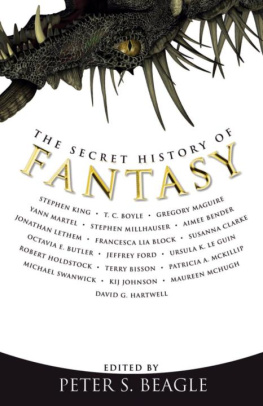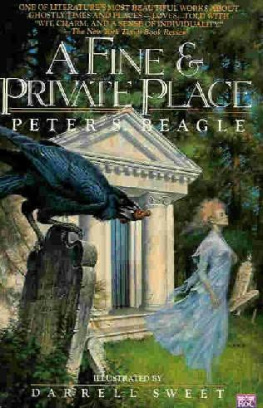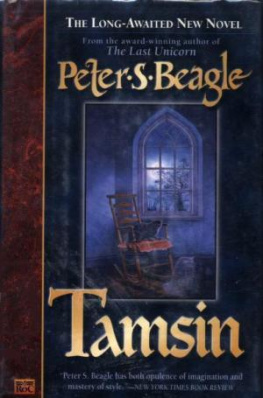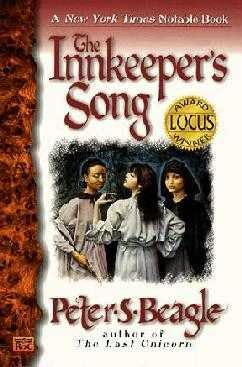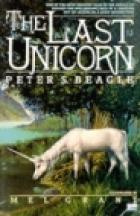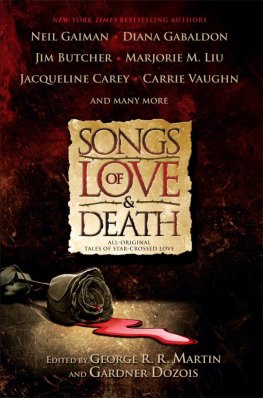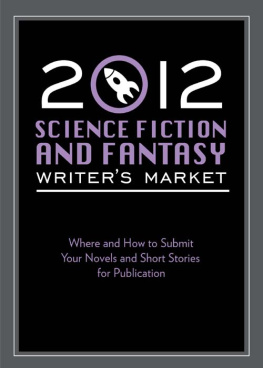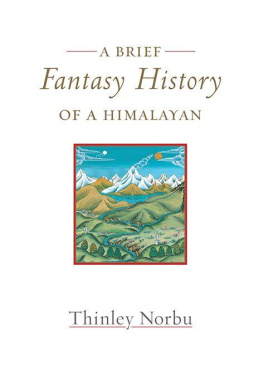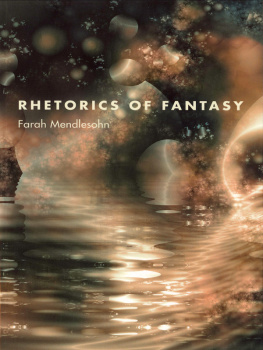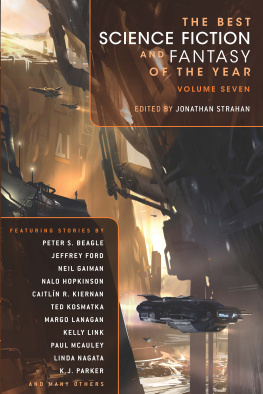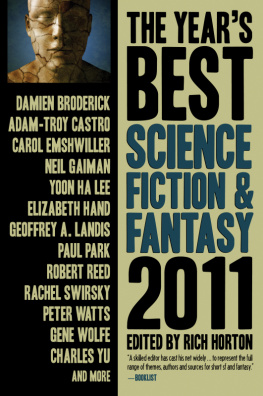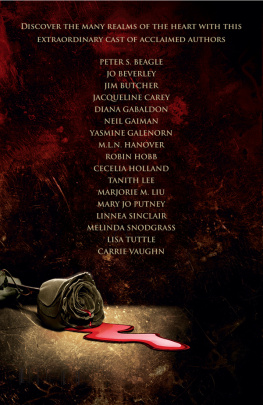




In memory ofRobert Holdstock, 1948-2009
And with gratitude to Ellen Datlow, John Kessel, Jill Roberts, Bernie Goodman, and Jacob Weisman
Introduction 2010 by Peter S. Beagle
"Ancestor Money" 2003 by Maureen F. McHugh. First appeared in SCI FICTION, October 1, 2003.
"Scarecrow" 2001 by Gregory Maguire. First appeared in Half-Human, edited by Bruce Coville (Scholastic Press: New York). Reprinted by permission of the author.
"Lady of the Skulls" 1993 by Patricia A. McKillip. First appeared in Strange Dreams, edited by Stephen R. Donaldson (Spectra: New York).
"We Are Norsemen" 1977 by T. C. Boyle. First appeared in Harper's Magazine, September 1977. Reprinted by permission of Georges Borchardt, Inc. on behalf of the author.
"The Barnum Museum" 199o by Steven Millhauser. First appeared in The Barnum Museum (Simon & Schuster/Poseidon: New York).
"Mrs. Todd's Shortcut" 1984 by Stephen King. First appeared in Redbook, May 1984.
"Bears Discover Fire" 199o byTerry Bisson. First appeared in IsaacAsimov's Science Fiction Magazine, August 199o.
"Bones" 2001 by Francesca Lia Block. First appeared in Rose and the Beast (HarperTeen: New York).
"Snow, Glass, Apples" 1994 by Neil Gaiman. First appeared in Snow, Glass, Apples (Dreamhaven Books: Minneapolis, MN).
"Fruit and Words" 2001 by Aimee Bender. First appeared in Mid-American Review Volume XXII, Number t, Fall 2001.
"The Empire of Ice Cream" 2003 by Jeffrey Ford. First appeared in SCI FICTION, February 26, 2003.
"The Edge of the World" 1989 by Michael Swanwick. First appeared in Full Spectrum 2, edited by Lou Aronica, Shawna McCarthy, Amy Stout, and Patrick LoBrutto (Doubleday: New York).
"Super Goat Man" 2004 by Jonathan Lethem. First appeared in The New Yorker, April 2004.
"John Uskglass and the Cumbrian Charcoal Burner" 2006 by Susanna Clarke. First appeared in The Ladies of Grace Adieu and Other Stories (Bloomsbury: New York).
"The Book of Martha" 2003 by Octavia E. Butler. First appeared in SCI FICTION, May 21, 2003.
"The VitaAEterna Mirror Company" 1993 by Yann Martel. From The Facts Behind the Helsinki Roccamatios by Yann Martel (Knopf Canada, 1993). Reprinted with permission of the author.
"Sleight of Hand" 2009 by Peter S. Beagle. First appeared in Eclipse Three, edited by Jonathan Strahan (Night Shade Books: San Francisco).
"Mythago Wood" 1981 by Robert Holdstock. First appeared in The Magazine ofFantasy & Science Fiction, September 1981.
"26 Monkeys, Also the Abyss" 2008 by Kij Johnson. First appeared in Asimov's Science Fiction, July 2008.
"The Critics, the Monsters, and the Fantasists" 2007 by Ursula K. Le Guin. First appeared in Wordsworth Circle, January 2007.
"The Making of the American Fantasy Genre" 2009 by David G. Hartwell. First appeared in The New York Review of Science Fiction, August 2009.
.. 9
...... 15
........ 31
...... 43
...... 55
...... 65
..... 81
...... 109
...... 125
...... 139
..... 151
..... 179
...... 195
..... 225
... 245
...... 275
...... 297
.... 341
. 355
. 367
I HAVE WRITTEN elsewhere that there was a time when all literature was fantasy. How could it have been otherwise, when a bad corn crop or a sudden epidemic among the new lambs could only have been caused by the anger of some god, or the spiteful sorcery of the people in the next village, eight miles over the hill, who were all demons, as everyone knew? Story then, in every part of the world, was a means of keeping the inhabited dark at bay, and of making some kind of sense out of survival. Even the best and most ambitious of post-Tolkien multi-volume epics inevitably miss that air of great art being first born of terror and ignorance. Beowulf, Gilgamesh, and the Popol Vuh were all created in darkness.
Much of what I glance over in the following pages is covered in greater and more knowledgeable detail further on by David Hartwell. David is a walking history of fantasy in general, and of American and European fantasy publication in particular. If I'm the Reader's Digest version, he's the Oxford University Press all by himself, and I'm both proud and grateful to include his contribution in the appendix to this book, along with Ursula K. Le Guin's classic essay "The Critics, the Monsters, and the Fantasists." Together, they make transparent, once and for all, the simple yet long-disregarded truth that the best fantasy is as much art as the best of any other form of storytelling. The critical bars on no account need to be lowered.
The segregation of fantasy from actual literature is a comparatively recent business, certainly no older than I am, and I'll be seventy-one in April. Genre fiction, as we understand the term mystery stories, Gothic horror tales, and romances (Westerns came along a bit later) appeared as early as the eighteenth century, along with the earliest stories written specifically for children; even so, writers today regarded as classic fantasists, like Lewis Carroll, Kenneth Grahame, Lord Dunsany, James Branch Cabell, Arthur Machen, H. G. Wells, H. Rider Haggard, and William Hope Hodgson, were all recognized as serious mainstream artists in their time. Cabell's novel Jurgen, in particular, was the target of a two-year obscenity trial, brought by the New York Society for the Suppression of Vice; it did wonders for sales, and remains his best-known book today.
Later, despite the continued flowering of pulp magazines with titles in the vein of Thrilling Wonder Stories, Astounding, Amazing, Captain Future, and Comet Stories, such utterly diverse writers as Thorne Smith, Robert Nathan, E. R. Eddison, Clark Ashton Smith, John Collier, Jack Finney, and T. H. White were considered and discussed in major critical venues, like anyone else. In 1954, the New York Times devoted the front page of its Sunday Book Review to W. H. Auden's laudatory essay on The Lord of the Rings; and similar space, in 1958, to White's The Once and Future King. As late as the 196os, my own novels A Fine & Private Place and The Last Unicorn both received serious individual reviews, just as though they were real books, worthy of such attention. I took it for granted then I wouldn't today.
The above doesn't mean, incidentally, that all of the writers I've mentioned found commercial success, or even made a decent living from their work. When they did strike it rich, it was most often due to a fortunate, usually irreproducible circumstance, as with Cabell's obscenity trial. The Lord of the Rings, for instance, was no sort of a bestseller when Houghton Mifflin first published it in this country; nor did it become one for more than ten years. I remember being unable to find it in any bookstore until, in 1958, as a student at the University of Pittsburgh, I ran the books to earth at the Carnegie Library, and disappeared into my dorm room for three days. It was the more affordable paperbacks (first published in the "pirate" edition by Ace Books; then, with Tolkien's formidable sanction, by Ballantine), that set off the great LOTR craze, still as yet unmatched, in the long term, even by Harry Potter. We'll consider the full effect of this phenomenon further in a moment.

